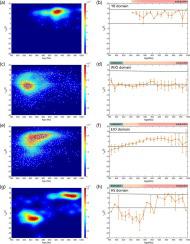Precambrian Research ( IF 3.8 ) Pub Date : 2021-09-13 , DOI: 10.1016/j.precamres.2021.106382 Yu Huang 1 , Xiao-Lei Wang 1 , Jun-Yong Li 1 , Di Wang 1 , Chang-Hong Jiang 1 , Lin-Sen Li 1

|
Precambrian sedimentary strata are widely distributed along the periphery of the Yangtze Block. However, the age, provenance and tectonic setting of the sedimentary successions on the northern margin still remain unclear, which exerted considerable influence on the understanding of Precambrian crustal evolution of the Yangtze Block. Here we report integrated detrital zircon U-Pb dates and Lu-Hf isotopes from the Dahongshan area to the northeast of the nuclei (i.e. the Kongling Complex) of the Yangtze Block. The youngest U-Pb dates of 995 Ma and 810 Ma of detrital zircon grains place constraints on the maximum depositional ages of the underlying Dagushi Group and the overlying Huashan Group, respectively. Both groups show pre-Mesoproterozoic age populations at ca. 2050 Ma and ca. 2700 Ma and corresponding εHf(t) values varying from –24.1 to + 2.3, consistent with counterparts of the Kongling Complex and Yangpo Complex in northern Yangtze Block. The εHf(t) values of Neoproterozoic (1000–800 Ma) detrital zircon grains in the Huashan Group show a decrease after ca. 880 Ma (from + 13.5 to –18.5), possibly indicating a transition from arc-continent collision to continental arc setting on the northern margin of the Yangtze Block. In combination with sedimentary characteristics and the new isotopic results, the Dagushi Group probably formed in a shallow marine basin setting and received dominant detritus from the Kongling and Yangpo complexes. In contrast, the Huashan Group received sediments recycled from the underlying Dagushi Group and contemporary igneous rocks in the Dahongshan and Kongling areas. The changes in provenance and tectonic setting recorded in the two sedimentary sequences suggest a tectonic transition from late Mesoproterozoic passive continental margin to Neoproterozoic subduction and accretion in response to the amalgamation of Rodinia supercontinent. On the basis of distinct location and history, Pre-Nanhua Neoproterozoic sedimentary sequences distributed in the periphery of Yangtze Block are dispersed into four separate domains. Through bivariate kernel density estimates and bootstrap resampling method, we have identified that these domains were characterized by asynchronous igneous impulse and heterogeneous character of igneous activity in early Neoproterozoic along with varying degrees of integration of crustal growth and reworking.
中文翻译:

扬子地块北部早新元古代构造演化——从大红山地区沉积层序看
前寒武纪沉积地层广泛分布于扬子地块外围。然而,北缘沉积层序的年代、物源和构造背景仍不清楚,这对认识扬子地块前寒武纪地壳演化产生了相当大的影响。在这里,我们报告了从大红山地区到扬子地块核(即孔岭杂岩体)东北部的综合碎屑锆石 U-Pb 日期和 Lu-Hf 同位素。碎屑锆石颗粒的最年轻 U-Pb 年龄分别为 995 Ma 和 810 Ma,分别限制了下伏大骨石群和上覆华山群的最大沉积年龄。两组都显示了大约在中元古代之前的年龄人口。2050 马和约。2700 Ma 和相应的 ε Hf(t) 值从 –24.1 到 +2.3 不等,与扬子地块北部的孔岭杂岩和洋坡杂岩的对应值一致。ε Hf( t )华山群中新元古代(1000-800 Ma)碎屑锆石颗粒的值在大约之后下降。880 Ma(从+13.5 到–18.5),可能表明扬子地块北缘从弧陆碰撞过渡到大陆弧设置。结合沉积特征和新的同位素结果,大沽石群可能形成于浅海盆地环境,并接收了来自孔岭和洋坡杂岩体的优势碎屑。相比之下,华山群接收了大红山和孔岭地区下伏大谷石群和当代火成岩回收的沉积物。两个沉积层序中记录的物源和构造环境的变化表明,从晚中元古代被动大陆边缘到新元古代俯冲和增生的构造转变是对罗迪尼亚超大陆合并的响应。基于不同的位置和历史,分布在扬子地块外围的前南华新元古代沉积层序分散为四个独立的区域。通过双变量核密度估计和自举重采样方法,我们已经确定这些域具有异步火成岩脉冲和早期新元古代火成岩活动的异质特征,以及不同程度的地壳生长和改造一体化的特征。基于不同的位置和历史,分布在扬子地块外围的前南华新元古代沉积层序分散为四个独立的区域。通过双变量核密度估计和自举重采样方法,我们已经确定这些域具有异步火成岩脉冲和早期新元古代火成岩活动的异质特征,以及不同程度的地壳生长和改造一体化的特征。基于不同的位置和历史,分布在扬子地块外围的前南华新元古代沉积层序分散为四个独立的区域。通过双变量核密度估计和自举重采样方法,我们已经确定这些域具有异步火成岩脉冲和早期新元古代火成岩活动的异质特征,以及不同程度的地壳生长和改造一体化的特征。



























 京公网安备 11010802027423号
京公网安备 11010802027423号